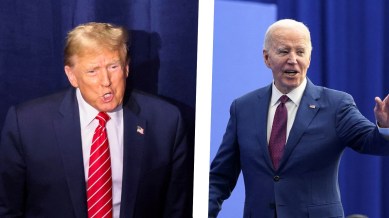Stay updated with the latest - Click here to follow us on Instagram
Trump vs Biden November rematch: What US presidential election history shows
In November 2024, Joe Biden will lock horns with his immediate predecessor, Donald Trump, in a rematch that finds a precedent in US politics nearly seven decades ago.

After Donald Trump cinched the Republican party’s nomination for the 2024 US Presidential elections, the former President is now gearing up for a showdown with sitting President Joe Biden in the first presidential rematch since 1956.
In November 2024, Biden will lock horns with his immediate predecessor in a rematch that finds a precedent in US politics nearly seven decades ago. In 1956, Republican President Dwight D Eisenhower had defeated Democrat Adlai Stevenson, whom he had fought at polls four years ago as well.
monthly limit of free stories.
with an Express account.
Sitting President’s advantage
Biden’s road to winning the Democratic party nomination this year was as smooth as expected. Sitting Presidents have almost always secured their party’s nomination to contest for a second term.
For instance, Democrat Barack Obama had contested, and won, the 2008 and 2012 elections, defeating Republican competitors John McCain and Mitt Romney respectively.
Before Obama, Republican George W Bush had defeated Al Gore and John Kerry in 2000 and 2004. His predecessor, Democrat Bill Clinton, had defeated George H W Bush and Bob Dole in 1992 and 1996.
In fact, Trump was the first President to not be re-elected to the post since 1992, when then-sitting President George H W Bush lost to Clinton.
Previous rematch of a presidential race
It is not uncommon for a presidential candidate who lost in a previous election to contest again. However, it is unusual for the same two candidates to face-off in consecutive elections.
To find the most recent example of this, we have to go back to the 1950s when Republican firebrand Dwight D Eisenhower and Democrat Adlai Stevenson II contested against each other in 1952 and 1956, with Eisenhower winning both times.
As a former military person born to a working-class family, Eisenhower’s work ethic, ability to bond with average blue-collar workers, his “family man” image and religious disposition had endeared him to the voters. It had stood in stark contrast to Stevenson’s upper-class upbringing — his grandfather had been the Vice President of the United States in 1893 and his father was the Secretary of State of Illinois in 1914. Stevenson himself had been educated at elite institutions like Princeton University and Northwestern University. He had been working as the United States Ambassador to the United Nations when he passed away in 1965.
Another such instance of a rematch occurred in the 1800s. In 1896 and 1900, Republican President William McKinley had contested against Democrat William Jennings Bryan, winning both times.
The only precedent for Trump
Only once in the history of US elections has a candidate succeeded in the task that Trump is attempting this time — to return to the White House.
In 1884, lawyer Grover Cleveland had been elected as the 25th President of the United States, defeating his Republican competitor James G Blaine in a historic election that saw a Democrat take control of the White House following the Civil War era.
However, he lost the next election to Republican Benjamin Harrison — even though Cleveland had won the popular vote, Harrison won the electoral college, and thereby, the elections. However, in the next general elections in 1892, Cleveland defeated Harrison, who was bogged down by opposition to his economic and tax policies.
Failures galore
Three former US Presidents have tried, and failed, to re-capture the White House.
Republican Theodore “Teddy” Roosevelt, who was the Vice President of the US in 1900, became the President after then-President William McKinley was assassinated while in office in September 1901. He later stood for elections and won in 1904, but he chose not to stand for re-election in 1908, instead endorsing his Republican ally William H Taft.
However, Roosevelt announced his intention to stand for elections in the next term, first challenging Taft for the Republican nomination in 1912, and, when that failed, standing on a third Progressive front ticket to challenge Taft and Democrat Woodrow Wilson. However, Roosevelt lost to Wilson, though he clocked in more votes than Taft.
Another such case is from 1850 when Whig party leader and then-Vice President Millard Fillmore became the President following then-Preident Zachary Taylor’s death. However, Fillmore’s attempts to secure a second term in 1856 ended in a failure.
Prior to that, Democrat Martin Van Buren, who had been the President of the United States in 1836, lost his re-election bid in 1840 to Whig Party leader William Henry Harrison.